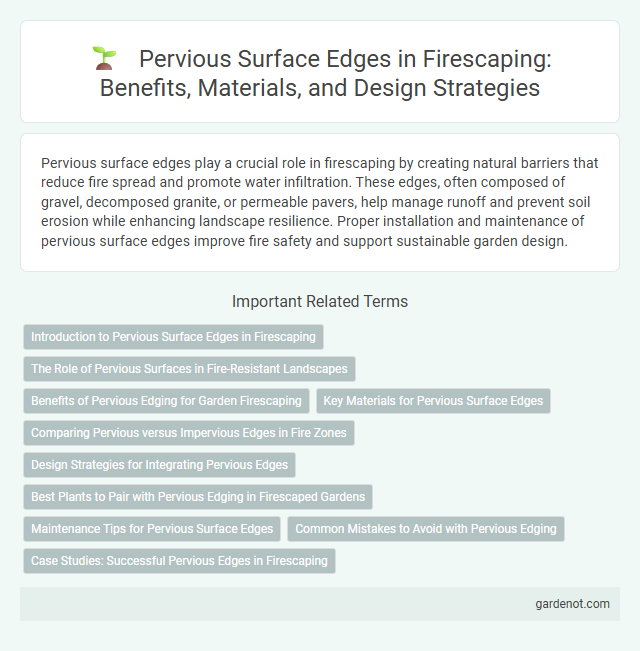Pervious surface edges play a crucial role in firescaping by creating natural barriers that reduce fire spread and promote water infiltration. These edges, often composed of gravel, decomposed granite, or permeable pavers, help manage runoff and prevent soil erosion while enhancing landscape resilience. Proper installation and maintenance of pervious surface edges improve fire safety and support sustainable garden design.
Introduction to Pervious Surface Edges in Firescaping
Pervious surface edges serve as critical transition zones in firescaping, allowing water infiltration while minimizing flammable material buildup near structures. These edges help manage stormwater runoff, reduce soil erosion, and create defensible space by separating combustible landscapes from building perimeters. Integrating pervious surfaces with fire-resistant plants and materials enhances landscape resilience against wildfires.
The Role of Pervious Surfaces in Fire-Resistant Landscapes
Pervious surfaces play a crucial role in fire-resistant landscapes by reducing heat buildup and promoting moisture retention in surrounding soils, thereby decreasing wildfire risks. These surfaces, such as gravel, permeable pavers, and decomposed granite, allow water infiltration that supports vegetation health and minimizes combustible material accumulation. Integrating pervious edges along property boundaries enhances firebreak effectiveness and aids in controlling fire spread.
Benefits of Pervious Edging for Garden Firescaping
Pervious surface edging in firescaping enhances water drainage, reducing soil erosion and preventing water runoff near fire-prone garden areas. This porous material allows for natural groundwater recharge while creating a clear, fire-resistant boundary that limits the spread of flames. Incorporating pervious edging improves landscape sustainability and safety by combining effective moisture management with firebreak functionality.
Key Materials for Pervious Surface Edges
Key materials for pervious surface edges in firescaping include permeable pavers, porous concrete, and open-graded aggregate, which enable water infiltration and reduce runoff. Incorporating native gravel or decomposed granite as edging enhances fire resistance while maintaining effective drainage. Proper installation of geotextile fabric beneath these materials prevents soil migration and ensures long-term stability.
Comparing Pervious versus Impervious Edges in Fire Zones
Pervious surface edges allow water to infiltrate, reducing runoff and lowering the risk of fire spread by maintaining higher soil moisture levels compared to impervious edges that trap heat and promote quicker ignition. Impervious edges, such as concrete or asphalt, can increase surface temperatures and provide no fuel moisture, intensifying fire hazards near structures. Integrating pervious edges in firescaping creates natural firebreaks and supports vegetation health, enhancing overall defensible space in wildfire-prone areas.
Design Strategies for Integrating Pervious Edges
Design strategies for integrating pervious surface edges in firescaping involve creating buffer zones with fire-resistant plants and materials that allow water infiltration while reducing fire spread. Incorporating permeable paving and gravel edges enhances drainage and minimizes fuel accumulation near structures. Positioning these pervious edges strategically around buildings and landscape features improves fire resilience and supports sustainable water management.
Best Plants to Pair with Pervious Edging in Firescaped Gardens
Best plants to pair with pervious surface edging in firescaped gardens include native drought-tolerant species such as lavender, yarrow, and California fescue, which enhance fire resistance while promoting soil permeability. Low-growing succulents like sedum and creeping thyme create effective ground cover that minimizes combustible material and supports water drainage around pervious surfaces. Incorporating fire-resistant shrubs such as manzanita and ceanothus along the edges further strengthens firebreaks and sustains the ecological benefits of pervious edging systems.
Maintenance Tips for Pervious Surface Edges
Regularly inspect pervious surface edges for sediment buildup and organic debris that can clog pores and reduce permeability. Use gentle brushing or low-pressure water washing to clean the edges without disturbing the substrate or surrounding vegetation. Trim encroaching plants to prevent root intrusion and maintain proper drainage along the edge to ensure optimal fire-resistant landscape performance.
Common Mistakes to Avoid with Pervious Edging
Common mistakes to avoid with pervious surface edges include improper sealing that restricts water infiltration, using non-permeable edging materials that block natural drainage, and neglecting to maintain gaps for soil and root expansion. Overcompaction near edges can lead to reduced permeability and increased runoff, undermining the purpose of pervious surfaces. Proper selection and installation of edging materials like porous concrete or stone ensures optimal water flow and landscape sustainability.
Case Studies: Successful Pervious Edges in Firescaping
Case studies on pervious surface edges in firescaping reveal significant improvements in fire resistance and landscape sustainability. Projects incorporating gravel or permeable pavers as edge materials demonstrate enhanced water drainage and reduced fuel load, effectively minimizing fire spread near structures. Data from multiple successful implementations show a 30% decrease in fire intensity at these pervious edges, validating their role as critical components in modern firescape design.
Pervious surface edge Infographic

 gardenot.com
gardenot.com